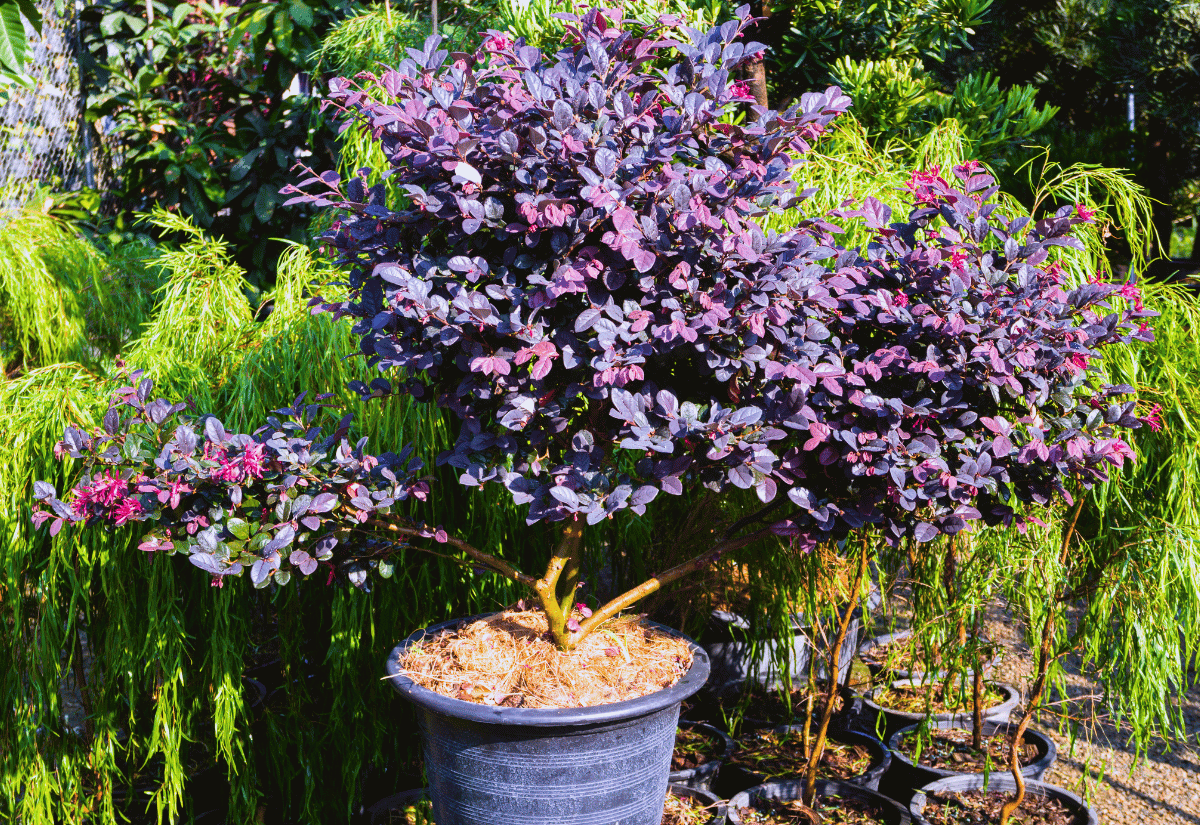
Purple foliage on trees and shrubs isn’t just unusual – it can truly amplify the garden with their striking dark silhouettes, bringing depth, intensity, and even drama to your outdoor space. The dense and lush leaves, in shades of plum, burgundy, wine, mulberry, and sometimes bordering on black, stand out visibly and proudly against the green backdrop of other plants.
These exceptional trees and shrubs are unrivaled in their ability to diversify the garden’s monotonous greenery, infusing it with a brilliant display of vibrant and rich hues that leaves a lasting impact.
Eye catching and amazing at the same time, the color of nobility but also spirituality on bushes or in the crowns of trees can also be a great focal point, and it can literally lift up any space, giving its structure as well as an original, unexpected touch – and a really plush and sumptuous, even aristocratic look.
For hedges or borders, for specimen or mass planting, or maybe to decorate the front path and door of your house, trees and shrubs with purple leaves are really exceptional, but there are not very many.
This is why we collected the very best varieties of purple-leaved deciduous and evergreen shrubs and trees, those that will give you deep purple shades, and transform your garden with their sublime beauty!
We may earn commission from links on this page, but it won’t cost you extra. We only recommend products we’ve personally used or believe will benefit our readers. Why Trust Us?
12 Captivating Ornamental Trees and Shrubs With Intense Purple Leaves That Will Take Your Breath Away
Purple-leaved plants are a popular choice for gardeners who want to add a burst of color and interest to their landscape. From the smallest shrubs to the tallest trees, there are many varieties of plants that feature stunning purple leaves.
Whether you’re looking for a small shrub or a large tree, there is sure to be a variety of purple-leaved plant that will suit your needs and add a touch of color and beauty to your garden.
Let’s take a look at some of the most breathtaking purple-leaved ornamental trees and shrubs that can add a touch of royalty to your garden.
1: ‘Atropurpurea’ Japanese Barberry (Berberis Thunbergii ‘Atropurpurea’)
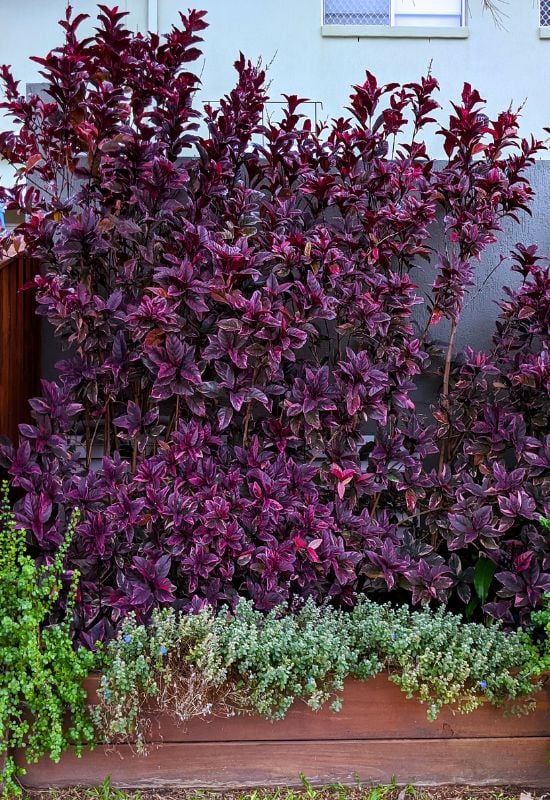
Both dense and intense, the foliage of ‘Atropurpurea’ Japanese barberry has a deep purple shade with red blushes that glows warmly all through the warm season.
Made up of many, small, ovate and glossy leaves that come on intricate thorny branches for an overall globular habit, it will fall as winter approaches, but lovely crimson and shiny berries will dangle all through the cold season, for color and for birds.
The small flowers are pale yellow, and fragrant, pretty but not the main attraction of this shrub. And if you want a smaller version, you can grow ‘Atropurpurea Nana’, a dwarf variety that only grows to a maximum of 2 feet tall (60 cm) and 3 in spread (90 cm), which has won the Award of Garden Merit by the Royal Horticultural Society.
Ideal for color and depth in hedges, borders, screens and rock gardens, but also flower beds, Japanese barberry ‘Atropurpurea’ and its smaller sister ‘Nana’ are favorite garden shrubs, low maintenance and easy to find.
2: ‘Bloodgood’ Japanese Maple (Acer palmatum ‘Bloodgood’)
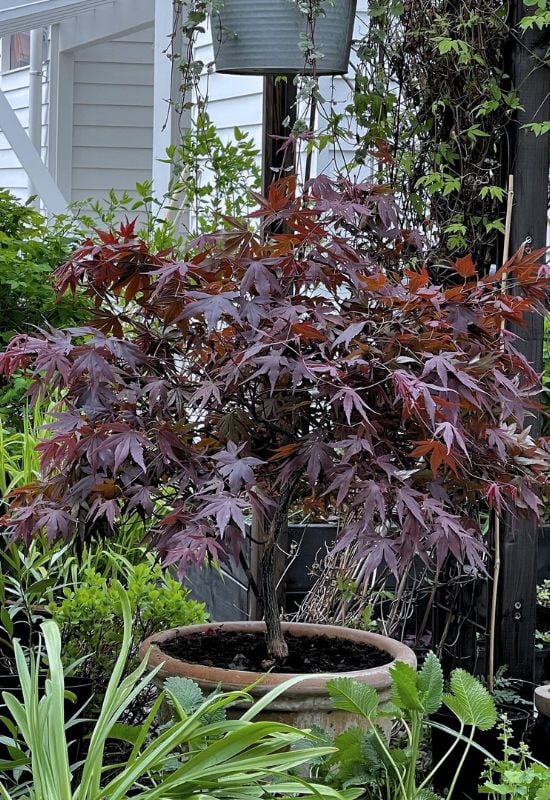
A small tree with impressive foliage, ‘Bloodgood’ is a cultivar of Japanese maple that’s won the Award of Garden Merit by the Royal Horticultural Society – and deservedly so!
The fine texture of the palmate leaves that hang beautifully on the elegant, arching branches is only matched by its deep burgundy purple color! The blackish red bark of this variety simply adds to the depth and beauty of this garden queen.
It will also bloom in spring, with small but very attractive flowers of our star color: purplish… And they are also followed by red fruits in summer.
‘Bloodgood’ Japanese maple deserves a focal point in a natural looking garden: as a specimen tree it will certainly shine, and it’s suitable to oriental gardens as well as cottage, English country, urban and suburban designs.
3: ‘Black Beauty’ Elderberry (Sambucus nigra ‘Black Beauty’)
For a spot of dark intensity in your garden, there’s a shrub you cannot miss: ‘Black Beauty’ elderberry; and you can even train it into a small tree!
The lush, lacy pinnate dark purple leaves of this cultivar will stay on the branches from spring to fall, giving you great contrast with other plants, and… The umbels of pink star shaped flowers with a strong lemon scent that come in summer will add extra drama, but with a romantic touch, to the ensemble.
Then, when they wilt away, glossy berries of an almost dark, still purplish shade, will ripen and attract birds. Then again, you could take part in the feast, because they are not just edible, but nutritious and delicious.
Winner of the Award of Garden Merit by the Royal Horticultural Society, ‘Black Beauty’ elderberry will add depth and drama to any natural looking garden in hedges, birders or even as a specimen plant!
Shop From Nature Hills Nursery4: ‘Diablo’ Common Ninebark (Physocarpus Opulifolius ‘Diabolo’)
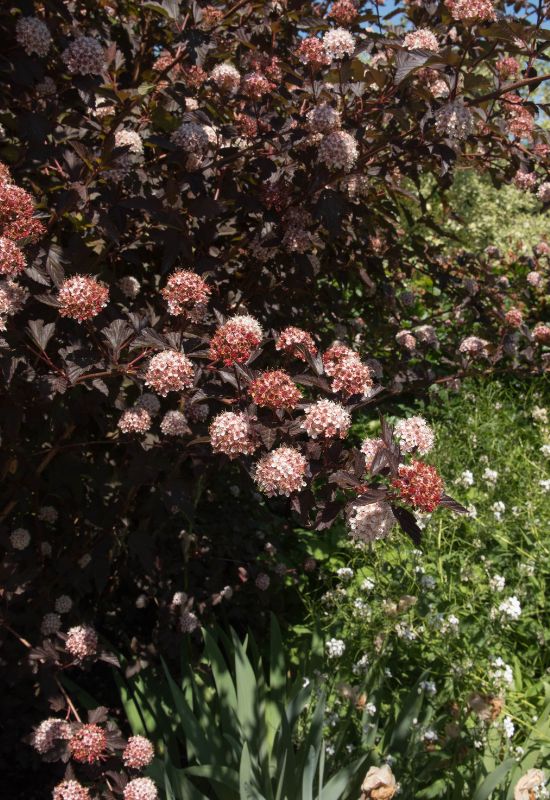
For decidedly purple foliage, ‘Diablo’ common ninebark is a shrub with very few matches indeed. The deeply lobed, large and serrated leaves form dense clumps with an intense and dark wine shade of our color, though in warm climates they can take on shades of green during the hot days of summer.
By contrast, the dense clusters of cream white flowers that open from pink buds, packed with elegant stamens appear at the tips of the branches to offer your garden a refreshing contrast! This is a deciduous species, so, in winter you will enjoy the peeling bark of this bush, usually hidden, while it reveals the layer of redfish brown underneath!
Yet another winner of the Award of Garden Merit by the Royal Horticultural Society, cold hardy ‘Diablo’ common ninebark will suit any informal garden style in shrubs, borders and screens or on banks and slopes.
5: ‘Newport’ Cherry Plum (Prunus cerasifera ‘Newport’)
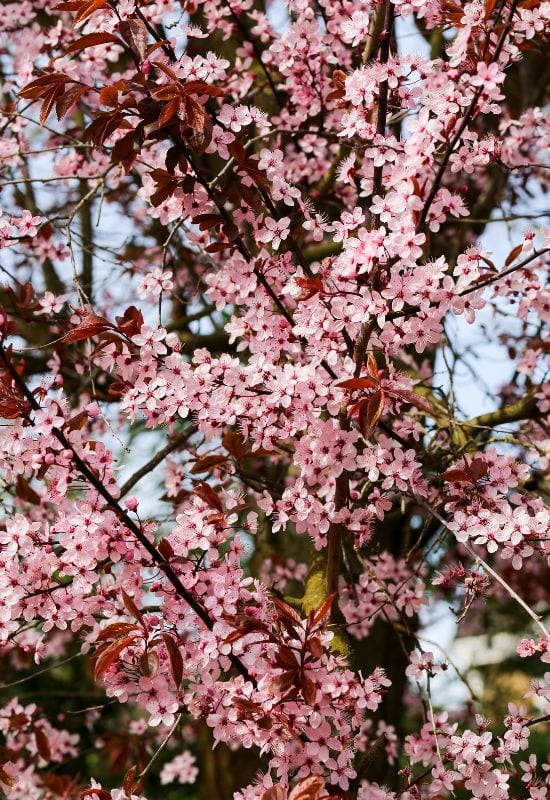
‘Newport’ cherry plum makes a theme of the color purple… This small tree in fact has deep purple leaves, elliptical, pointed and finely serrated… Which grow on purple branches, and they bear wine purple plums!
There’s just one thing that diverts from this chromatic range: the blooms, delicate and short lived, but massive in numbers, with five white to pale pink petals, which are fragrant and they give you a striking floral display in spring.
Having said so, if you look closely at the centers of the flowers… You will see a ti y spot of magenta purple as well! Naturally, you can eat the fruits, as will visiting birds.
Mainly a decorative tree, ‘Newport’ cherry plum is also good for fruit gardens. It is great for any informal garden style, as a specimen tree or in clumps.
6: ‘Royal Purple’ Smokebush (Cotinus coggyria ‘Royal Purple’)
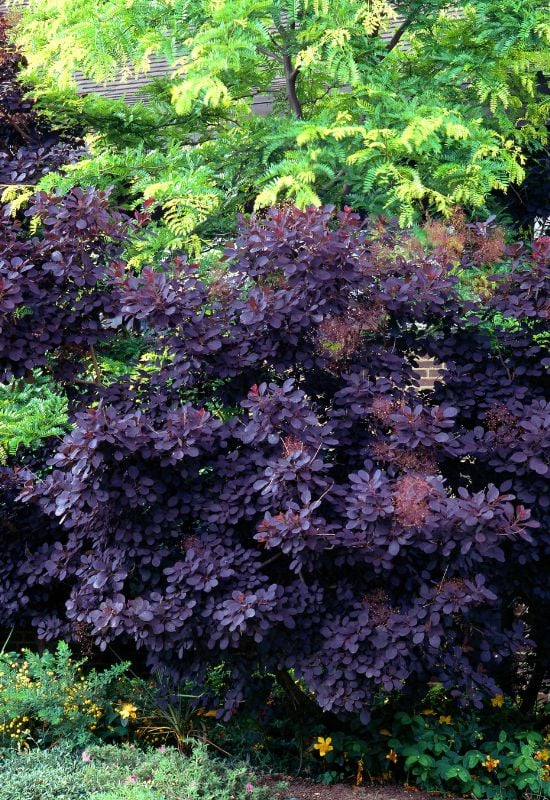
A large deciduous shrub with amazing colorful foliage is ‘Royal Purple’ smokebush. The large, rounded leaves actually emerge of a vibrant shade of maroon red, with copper hints, but they will soon ripen to wine purple in early summer and they will keep this shade till they fall to the ground forming a noble looking carpet in late fall.
The massive blooms, instead, look like clouds of smoke, or bette candy floss: pink and fluffy, the blossoms are huge and they cover the whole bush for months on end. This cultivar with intense tints has also won the prestigious Award of Garden Merit by the Royal Horticultural Society.
You can grow ‘Royal Purple’ smokebush for its blooms and foliage in pink and purple as a specimen plant, but also in hedges, screens and tall borders, as long as your garden likes a bit of romance and it has an informal design.
7: ‘Black Pearl’ Eastern Redbud (Cercis canadensis ‘Black Pearl’)
Imagine a tree covered in heart shaped, almost black leaves, that shine when drop of rain fall on them: you have just pictured ‘Black Pearl’ eastern redbud!
The foliage on its broad and dense rounded crown is actually of a very dark purple shade, hence the name, and it stays so till fall, when it fades to chartreuse yellow, for an impressive colorful end of season display!
Before it emerges, you will see the branches cover in pea like, bright pink and magenta flowers, that last quite a long time in their clusters! It punches a lot of drama and personality in a fairly small space!
Low maintenance but very rewarding, ‘Black Pearl’ eastern redbud is an excellent specimen tree for a deep and dramatic effect, or you can grow in in groups, to vary the foliage coloring, or even use it in hedges and screens.
8: ‘Purple Daydream’ Chinese Fringe Flower (Loropetalum Chinense ‘Purple Daydream’)
A small but dense flowering shrub with foliage of our color is ‘Purple Daydream’ Chinese fringe flower! The alternate, elliptical and pointed leaflets that grow on the thin branches in fact form a thicket with shades of purple that include wine, grape, plum but also eggplant, and you can see some greenish under blushes in some of them!
And they will stay on all year round, because it is an evergreen variety! The flowers will come in spring, and they are spider like, bright pink red, quite profuse and they offer an interesting and intense contrast with the foliage.
Easy to grow, very low maintenance, ‘Purple Daydream’ Chinese fringe flower will suit many functions in your garden: foundation planting, mass planting, or in beds, borders hedges and even in containers, its purple leaf palette is always guaranteed!
9: ‘Dawick Purple’ European Beech (Fagus sylvatica ‘Dawick Purple’)
Meet the purple giant of our list: ‘Dawick Purple’ European beech, reaching 50 feet tall (15 meters) with a dense columnar crown of broadly elliptic, glossy leaves of the deepest burgundy shade you will ever see.
The foliage will start off as reddish brown, but it will soon mature to its dark and intense hue… When it falls, roughly with the first frost, you will be left with a stunning trunk with pale gray bark, like a greek pillar!
The flowers will come in spring, and they are inconspicuous, but pretty with their delicate yellow green tint. This tree has also won the Award of Garden Merit by the Royal Horticultural Society.
You will need a large garden to grow ‘Dawick Purple’ European beech, and especially, neighbors that won’t complain for its long shadow… But if you do have the space, this towering purple tree is an excellent specimen plant or it could be part of a tall and colorful screen.
10: Purple Sage (Salvia officinalis ‘Purpurescens’)
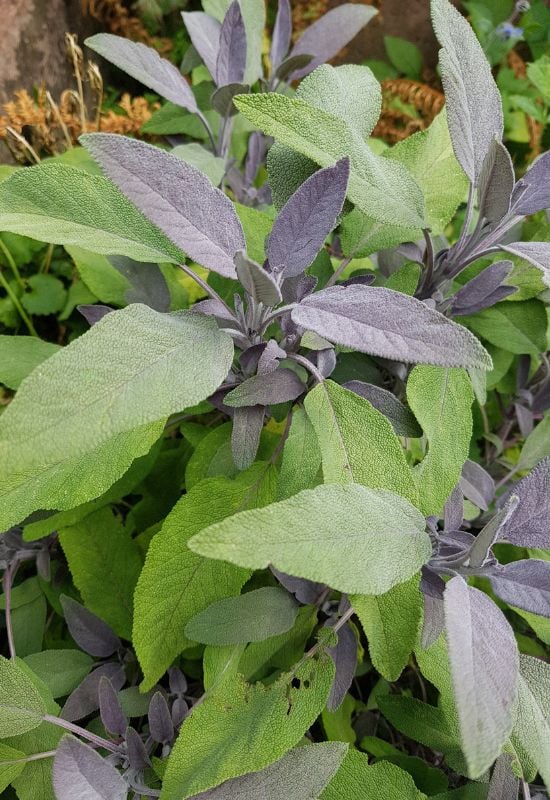
For a smaller garden or spot, a small shrub with interesting leaf coloring is purple sage. The soft looking, long and pointed elliptical and very aromatic leaves, coated in a fine downy fuzz do have purple in it, but on the violet range, but they will also display green and silver shades as well.
Dense and forming a low clump, they will also produce straight flower spiked with lavender blue flowers that attract lots of butterflies, bees and pollinators. And don’t be put off by the strange and unusual palette of this shrublet: you can use its foliage to cook, as it has the exact same property of its green sister.
Well, it has the extra gear when it comes to decorative value, and in fact it has won the famous Award of Garden Merit by the Royal Horticultural Society!
You can grow purple sage in beds and borders, rock gardens and containers of any informal style garden, like cottage or city designs, but it is virtually a must have shrub if you have a Mediterranean yard!
11: Purple Holy Basil (Ocimum sanctum)
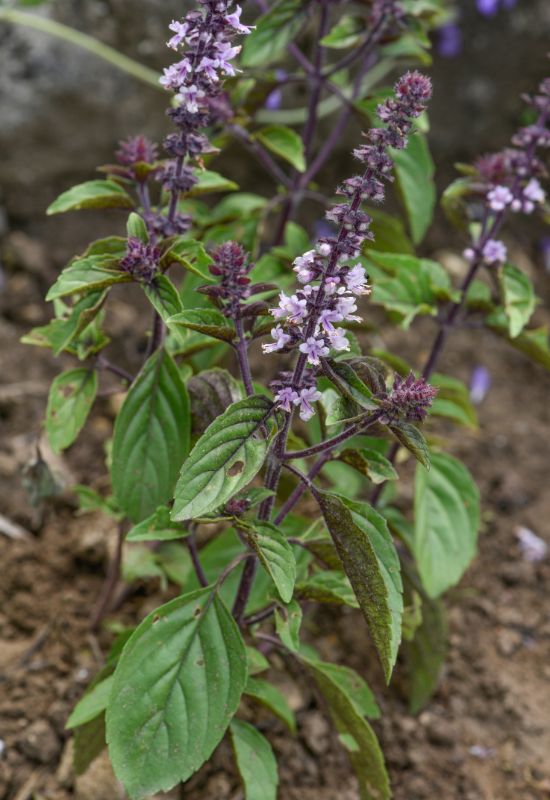
Purple holy basil is atropical subshrub with fine, serrated burgundy leaves that form a dense, if low, little clump. It comes from India, where it is a sacred plant, and often used in Ayurvedic medicine.
The blooms will come on upright stems, and they can be fully white or mauve in color. Easy to grow in warm countries, it also has a deep spiritual value for Hindus and it is edible, and in fact, quite common in stir fries!
Do make sure you pick the purple variety, however, because there is also a bright green one. And don’t forget to use the tiny leaves, both fresh or dry, for a good, soothing tea.
While in hot climates purple holy basil is a proper small shrub, in colder climates it is easily grown as a humble annual, for both decorative and culinary purposes. It will spark up a warm light under shrubs, in beds and borders, or also in containers, bringing its spiritual presence to your green spaces.
12: ‘Purpurea Tricolor’ European Beech (Fagus sylvatica ‘Purpurea Tricolor’)
Here is a European variety with a surprising and brightly colored twist: ‘Purpurea Tricolor’ European Beech. Smaller than its sister ‘Dawick Purple’, which we met before, this cultivar has glossy, veined, elliptical to ovate leaves with a deep burgundy center, but bright magenta to pink and red edges!
This outer area will then turn to bronze when fall comes, and finally, it will turn of a strong golden shade before winter… And they are big, reaching 4 inches in length (10 cm)!
With a rounded, oval crown, it cannot be missed. The green yellowish flowers that come in spring are inconspicuous, but they are also followed by bristly fruits.
A spectacular specimen tree, ‘Purpurea Tricolor’ European beech prefers fresh summers, or the pink edges of the leaves may burn in the heat. It would be a pity to grow it mixed in groups, unless you place it at the front – by far its best use is as a specimen to admire and marvel at!
Deep and Dramatic Purple Leaves in Trees and Shrubs
We have seen small shrubs and big trees, with leaves in many shades of purple, from violet to burgundy, with plum and wine thrown in as well… Purple foliage has a very stunning effect in gardens: it is intense, sometimes dark, even dramatic, but always interesting. And yes, it will always provide that change and focal point that every green space really needs!

Written By
Adriano Bulla
After many years as an academic in London, Adriano Bulla became a writer, publishing books like A History of Gardening, Organic Gardening and Elements of Garden Design; he then decided to become a gardener, following his childhood dream, and has been following his dream writing and gardening professionally in Southern Europe, where he has specialized in new and innovative organic gardening fields and techniques, like permaculture, regenerative agriculture, food forests and hydroponics.

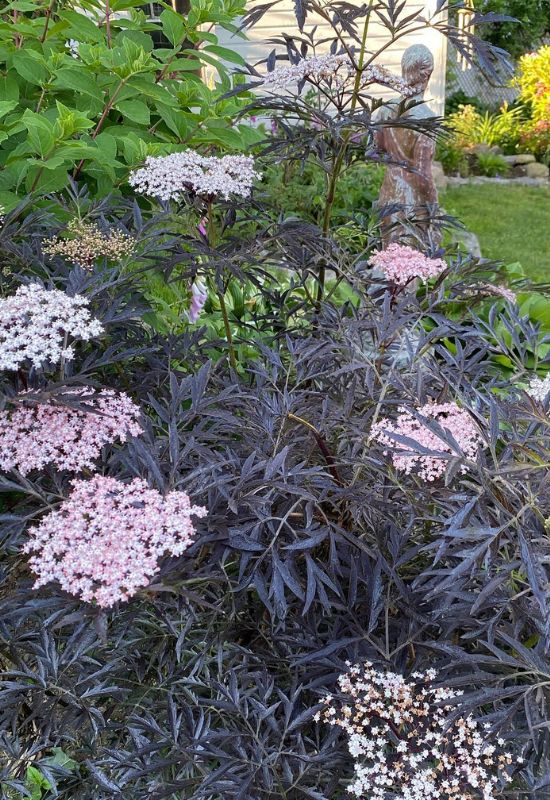
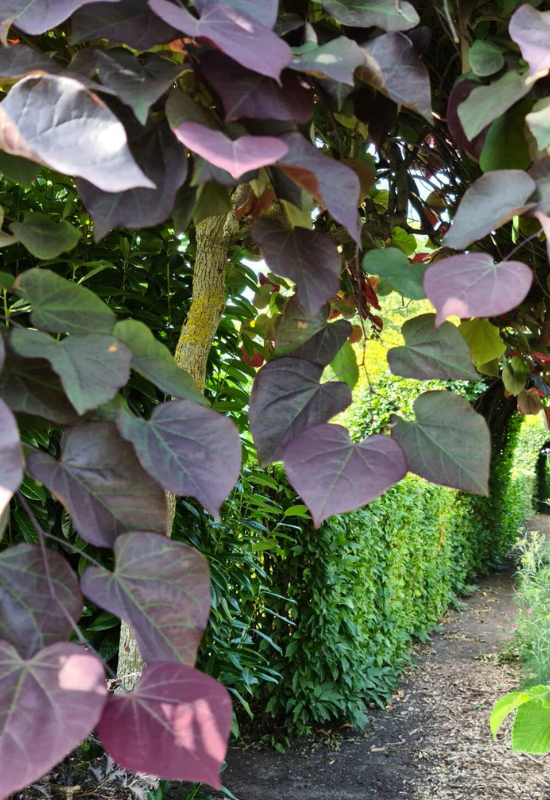
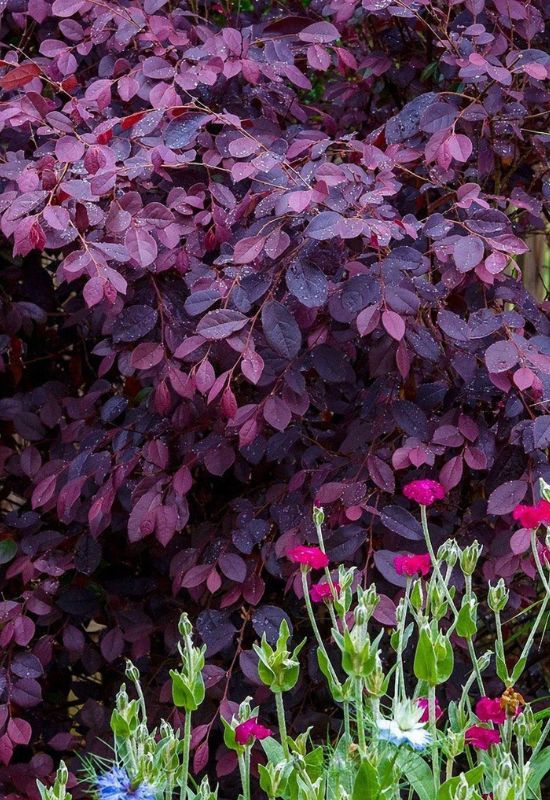
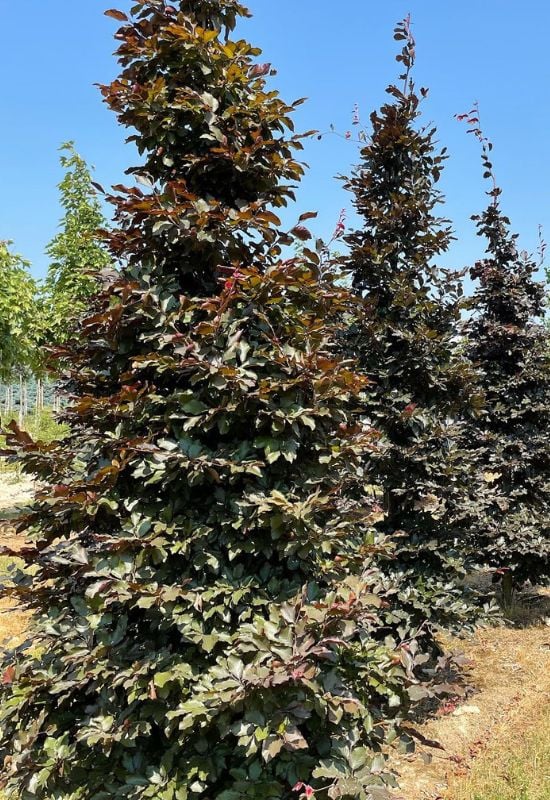
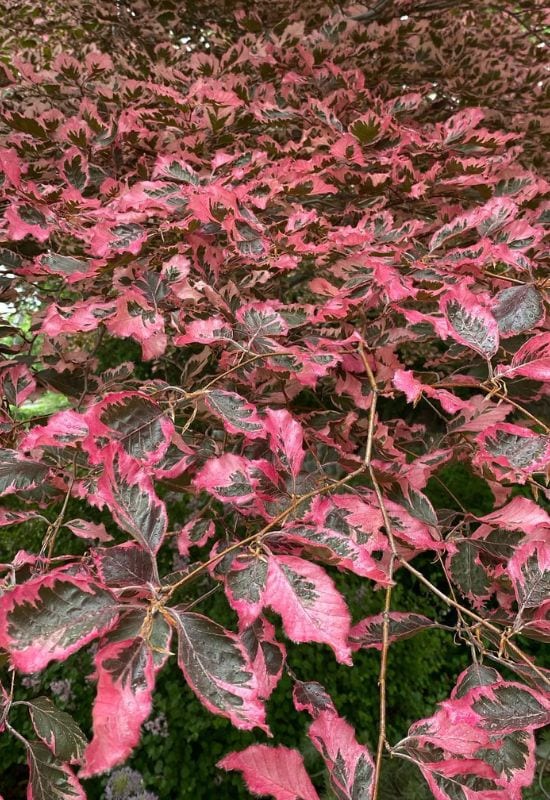
The color Purple, does it originate in a specific region or area in the US or Canada or Mexico?
If you move a plant that is indigenous to a certain area, are we vmvresking a natural chain of events, like the Weather or out trees in the lower part of the State of New York nit to change colors in the beginning of Fall, August 30 or 31, the last Sunday in August.
We have noticed out Trees do not turn Red, Orange and Gold and Brown any more in front of the Park, Hamilton Metz on the corner of Albany avenue and Lefferts avenue.
Is it because the Trees that were planted which were probably different from the ones that the late Hurricane knocked down across the street aren’t there anymore?
We receive a blast id Tropical Hurricanes every Summer.
Is there an Organization like Arbor Day that endured our proper Trees are in the areas they are supposed to be.
I normally order trees from them, but this time I want to make sure the MAPA is right.
Try travelling around the City if you can, New York City, you may find markings that indicate certain varieties of Shrubs, plants and trees that should be there.
You can always contact me at my many email addresses.
My name is Peppermint Patty.
Hamilton Metz Feild is in Brooklyn, nor to far from our World famous Boys & Girls High School on Fulton street and Utica avenue.
So, you are formally invited to visit our Great City not to far from New Jersey.
Signing off,
Peppermint Patty